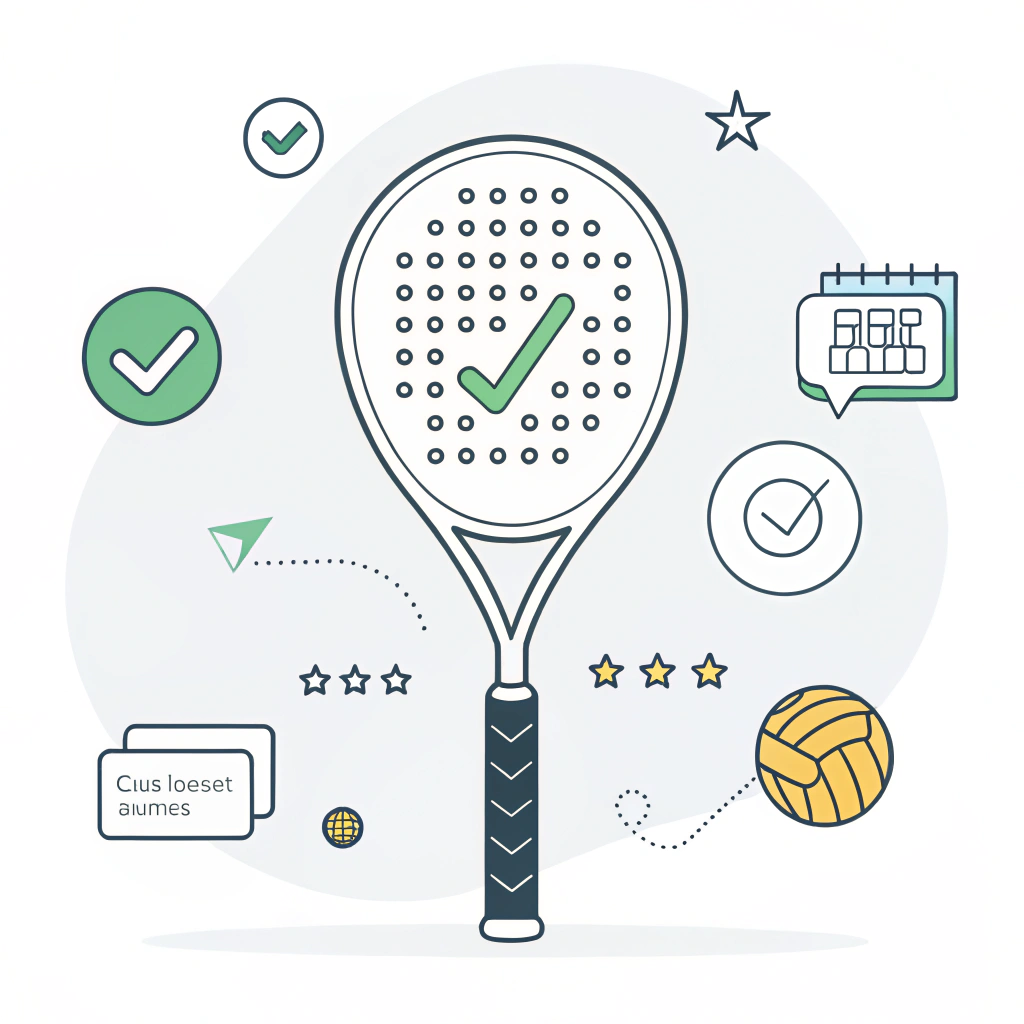Padel racket authenticity matters significantly for B2B procurement managers. In this article, we quickly explain that verifying authenticity involves checking branding details, material quality, certification markers, and production techniques. These practical steps help ensure that the padel rackets you procure meet high-quality industry standards and genuinely represent leading brands like those we produce at NEX Padel.
Procurement managers and quality assurance specialists often face the challenge of distinguishing genuine high-performance padel rackets from counterfeit products1. With increasing competition in the sporting goods market and the sophistication of fake products, establishing clear verification guidelines is essential. This article outlines specific indicators and a step-by-step solution to help you confidently evaluate and compare suppliers, ensuring that your inventory meets strict quality standards.
In the padel racket market, counterfeit products not only undermine brand reputation but also jeopardize the performance and safety of players. Procurement teams must accurately assess each product's origin and construction to avoid potential pitfalls. The key challenge is identifying subtle differences in manufacturing, materials, and design details that indicate authenticity.
Several factors contribute to the challenge:
- Complex Manufacturing Techniques: High-performance rackets require precision in materials such as carbon fiber2 (3k, 12k, 18k) and fiberglass3. Counterfeit products might mimic these materials superficially but fail on durability or performance.
- Inconsistent Branding: Authentic rackets contain detailed logos, serial numbers, and sometimes holograms that are missing or poorly reproduced in counterfeits.
- Certification Shortcomings: Genuine manufacturers comply with strict quality control processes and international standards, a step often skipped by counterfeiters.
Below is a checklist of essential indicators to assess the authenticity of a padel racket:
| Verification Item | Genuine Indicator | Counterfeit Warning Signs |
|---|---|---|
| Branding and Logos | Precision, clear placement, and sharp details | Blurry, misaligned, or inconsistent logos |
| Material Quality | Use of high-grade carbon fiber2 and fiberglass3 | Inferior materials, lack of expected texture |
| Serial Numbers & Holograms | Unique serial numbers, holographic stickers | Missing, duplicate, or poorly printed codes |
| Certification and Documentation | Comprehensive quality certificates and OEM standards4 | Incomplete or questionable documentation |
| Production Techniques | Advanced production processes ensuring durability | Simplistic, unmatched techniques |
Ensure that each checkpoint is thoroughly verified before finalizing contracts with suppliers. This table provides a clear decision-making framework to avoid procurement pitfalls.
Inspect the padel racket for clear, precise branding and fine print details. A real product typically shows uniform color-coding, evenly spaced logos, and a professional finish. If the racket feels light or imprecise in design, it might not meet the high standards expected from genuine manufacturers.
One of the most significant differentiators is the material. Authentic rackets boast robust construction using high-performance carbon fiber2 or pure fiberglass3. Validate these features by:
- Comparing the texture and density of the material.
- Checking for uniformity in the weave of the fibers.
- Confirming that the racket meets industry standards for impact resistance.
Always request quality assurance certificates from your supplier. Genuine products, especially those produced by reputed manufacturers like NEX Padel, come with complete documentation verifying the production process and materials used. Look out for internationally recognized certifications that attest to the durability and performance of the racket.
The design attributes of a padel racket can provide clues about its authenticity:
- Shape: Genuine rackets usually adhere to industry-standard shapes such as Diamond, Round, or Teardrop. Custom shapes are available but follow high-design precision guidelines.
- Weight and Balance: Ensure that the balance of the racket suits the players' needs. The weight distribution should accommodate both power and maneuverability.
- Handle Size and Grip: A genuine product features ergonomically designed grips that enhance comfort and control.
Check the reputation and history of your supplier. Established companies often have partnerships with well-known brands and a transparent production process. It is critical to confirm that your supplier operates within the industry standards and follows ethical sourcing and production methods.
Develop and implement a protocol that covers all aspects of authenticity verification. This protocol should include regular audits, on-site inspections, and third-party certifications. By maintaining a standardized checklist, procurement managers can systematically identify potential red flags in product quality.
Working with reputable manufacturers like NEX Padel ensures that the production process is transparent and adheres to high-standard practices. Our experience with renowned brands such as Hirostar, Reebok, and Starvie demonstrates a commitment to quality and innovation. Leveraging these established relationships, B2B buyers can confidently assess product authenticity.
Regular training sessions for procurement and quality assurance teams can enhance their ability to spot counterfeits. Providing up-to-date information on the latest manufacturing techniques and emerging counterfeit tactics is essential for maintaining a high level of scrutiny.
Modern verification techniques include digital verification apps, QR code scanning on packaging, and blockchain-based traceability systems5. These technological tools can further streamline the verification process and add an extra layer of quality control.
At NEX Padel, we understand the critical importance of product authenticity and quality assurance in today's competitive B2B market. With our advanced production techniques and strict adherence to quality control measures, we deliver padel rackets that provide unmatched performance and durability.
Our diverse product lineup—from Diamond, Round, to Teardrop shapes—caters to various player preferences, while our customizable options ensure that each order meets specific client requirements. By integrating rigorous quality checks at every stage of production, we ensure that every racket leaving our facility is built to withstand the demands of the game while meeting the highest industry standards.
We also support wholesale distribution of our premium padel balls, available in different wool compositions and with robust packaging to maintain consistent pressure. These products are crafted in collaboration with our trusted manufacturing partners, ensuring both price competitiveness and reliable quality.
- Implement a Detailed Checklist: Utilize the provided authenticity and quality table to guide your product evaluations.
- Request Full Documentation: Always insist on comprehensive certification documents and production details from suppliers.
- Perform Regular Inspections: Schedule routine factory visits or product sample testing to confirm adherence to production standards.
- Stay Informed: Keep updated with industry trends and authentication technologies that could benefit your verification efforts.
- Consider Long-Term Partnerships: Work with suppliers who have established track records and a commitment to quality assurance.
Through these practices, you can significantly mitigate the risks associated with counterfeit padel rackets and safeguard the reputation of your business. A well-informed procurement strategy not only enhances product quality but also solidifies your market position as a trusted distributor or retailer of high-performance sporting goods.
Verifying the authenticity of padel rackets is a multi-step process of visual, material, and documentation analyses. From checking precise branding details to understanding advanced production techniques, procurement managers must leverage every available resource to differentiate genuine products from counterfeits. Our checklist and detailed guidelines offer a robust framework for this evaluation process.
NEX Padel stands ready to partner with you, providing quality products that meet the highest standards, backed by comprehensive documentation and proven manufacturing techniques. Adopting these verification practices will ensure that your sporting goods inventory remains authentic, high-performing, and trusted by your market.
Embrace a proactive approach towards quality assurance and partner with reputable manufacturers to secure the best products for your clientele.
People Also Ask
Q: How to know if a padel racket is original?
A: To verify if a padel racket is original, check for clear and precisely executed branding and logos, high-quality materials such as carbon fiber or fiberglass, and verification markers like serial numbers or holograms.
Q: How to tell if a padel racket is good?
A: A good padel racket is determined by its shape, weight, balance, handle size, material quality, and surface texture. These factors collectively contribute to the racket's performance, durability, and suitability for different playing styles.
Q: What is the lifespan of a padel racket?
A: The lifespan of a padel racket varies based on usage. Continuous daily play may wear a racket down in 4-6 months, while regular usage about 2-3 times a week could extend its service life to approximately one year.
-
Counterfeit Products: Read this article to understand the risks and challenges associated with counterfeit products in the sporting goods industry, including how they can impact brand reputation and product safety. ↩ ↩
-
Carbon Fiber: Click here to learn about carbon fiber, its properties, manufacturing grades (3k, 12k, 18k), and why it is a preferred material in high-performance sporting equipment. ↩ ↩ ↩2 ↩3
-
Fiberglass: Discover the benefits and limitations of fiberglass as a construction material in sporting goods, and how it compares to other materials in terms of durability and performance. ↩ ↩ ↩2 ↩3
-
OEM Standards: Explore the concept of OEM standards, their role in maintaining consistent quality, and how adherence to these standards is critical for verifying product authenticity. ↩ ↩
-
Blockchain-based Traceability Systems: Learn how blockchain-based traceability systems work, and why they are becoming an essential tool in verifying the authenticity and traceability of products in modern supply chains. ↩ ↩







